The glory days for Marlin were from the early 1880s up to about the turn of the century, a time when they manufactured an impressive line of high-quality lever-action rifles and carbines. Marlin’s lever-actions were also offered in a wide range of calibers and sizes. These ranged from large rifles to handle big-game calibers to medium-framed rifles in pistol calibers (such as the .44-40 Winchester) down to small .22-caliber rimfire versions. The original Marlins were beautiful creations, at least as nicely crafted as those of their competition and, as a rule, the Marlins were much simpler. Those early models evolved into the more familiar modern versions of the classics, guns which we know today as the 336, the 444, and the 1895 models, built around the concepts originally introduced by John Marlin.
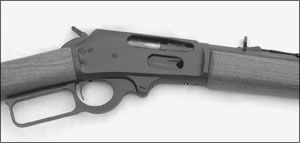
Author photos
Marlin rifles have been thought of by some shooters as “the other lever action.” Indeed, they have long played second fiddle to Winchester’s lever guns. And while it’s true that the modern Marlin Firearms Co. hasn’t paid a lot of attention to highly polish blue finishes and fancy wood, they have concentrated on making solid, dependable hunting rifles for longer than most of us can remember. These rifles use a robust and easy to understand action that makes for a dependable repeater that an owner can expect to last a lifetime (with, of course, the occasional help of a good gunsmith). Moreover, modern Marlin lever-actions also provide a sound starting point for anyone who wants to build a great custom lever gun.
The Marlin 336 series of rifles are a continuation of (and an improvement to) the Model 36, which was introduced in 1936. In turn, the Model 36 had even earlier origins that can be traced back to the Model 1893. The model designation 336 was used after an alteration was made to the Model 36 in 1948, when the bolt shape was changed to round, enabling the factory to build a stronger receiver around the bolt.
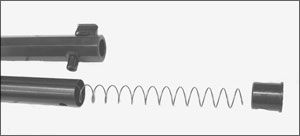
The 336-Series rifles are primarily used for hunting and are chambered for cartridges like the .30-30, .32 Winchester Special, and .35 Remington, though over the years they have been chambered for the .44 Magnum, .356 and .375 Winchester, and .444 Marlin. The larger Model 1895 in .45-70 caliber was “reintroduced” by Marlin in 1972, only this time, the new Model 1895 was built on the stronger, round-bolt concept like the one used in the 336 action. Marlin has closely followed the trends in public interest, with an emphasis in recent years on the needs of the cowboy-action shooter. A “cowboy” version of the 336 was introduced in 1999, offered in .30-30 or .38-55 Winchester calibers, along with a Cowboy Model 1895 chambered in .45-70.
Marlin Rifle Takedown Instructions
These instructions work with new-model Marlin Models 336, 444, and the post-1972 Model 1895. The procedures in these instructions are also applicable to older Model 336, 444, and 1895 models, with the major exception being that these earlier rifles were not equipped with a hammer-block safety.
1. I mentioned above that the Marlin is a simple design, and if you’re not already familiar with it, you’re about to find out how true that statement is.
Start by making sure the rifle is unloaded. Grasp the rifle around the wooden forearm and barrel with your left hand and take care to point the muzzle in a safe direction. With your right thumb, pull the Marlin’s hammer (#36) back until you hear one click, and press the hammer-block safety to the “safe” position by pushing it in from left to right (as viewed from the rear).
Now, open the action by pulling all the way down on the finger lever (#16) with your right hand. This is the time to check and be absolutely certain there is not a cartridge in the barrel’s chamber. Also, look through the bolt opening down into the action to make sure there is no cartridge lying in the carrier (#7) within the action.
Note:If there is a cartridge in the carrier block, when you close the lever, the rifle will be loaded. To safely unload a Marlin lever-action with a loaded magazine, keep the muzzle pointed in a safe direction and, keeping your finger away from the trigger, operate the lever to the fully open and fully closed positions several times. This will expel the cartridges in the magazine. Repeat the operation until there are no more cartridges expelled from the action.
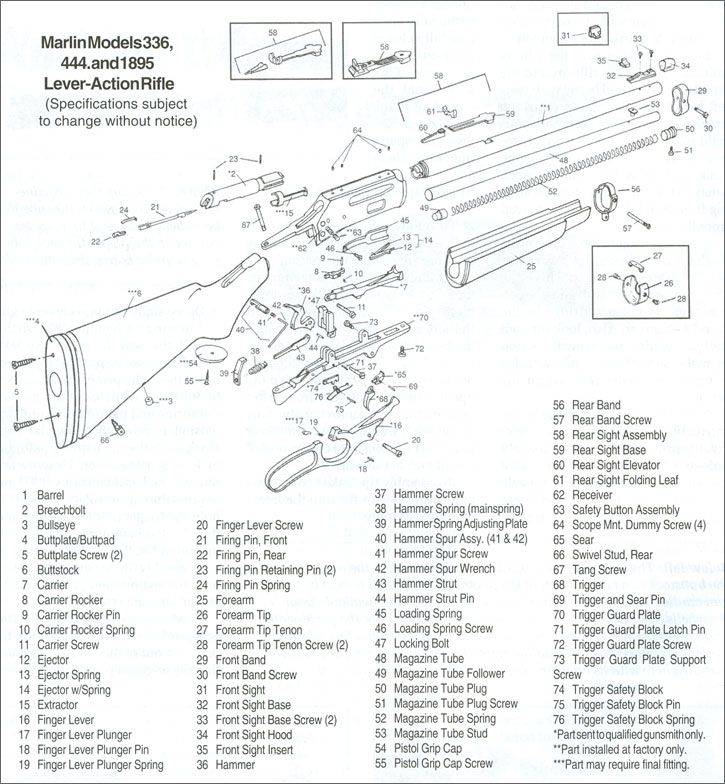
2.To remove the lever, the breech bolt, and buttstock, start by moving the finger lever so it is about halfway down, and unscrewing and removing the finger-lever screw (#20). Pull down on the finger lever and remove it out the bottom of the receiver (#62). Move the breech bolt (#2) all the way to the rear and out of the receiver, then lift out the ejector (#14) from inside the opening the bolt just came from. After unscrewing and removing the tang screw (#67) from the upper receiver tang, the buttstock (#6) can be pulled straight off to the rear.
Reassembly tip: Take careful note of how the ejector fits into the frame for later assembly. The front end of the ejector goes under the barrel.
3.Disassembling the receiver begins by lowering the hammer (#36) so that it’s all the way forward. Use your thumb or a tool to push down on the top of the mainspring-adjusting plate (#39). Then, while carefully holding the spring and plate captive until the tension is released, slide the plate along with the mainspring (#38) out to the side of the action. Unscrew and remove the hammer screw (#37) and depress the trigger-safety block (#74), hold the trigger (#68) to the rear, and then lift the hammer assembly (#36) up and out of the top of the receiver.
Assembly tip:Make careful note of how the mainspring parts all fit together for later assembly.
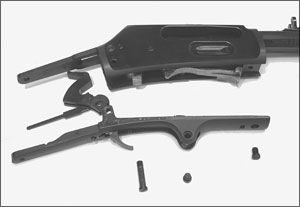
Next unscrew and remove the trigger-guard plate screw (#72) from the bottom-front of the trigger guard and the trigger-guard plate support screw (#73) from the left side of the receiver. The trigger-guard plate assembly (#70) can now be pulled down out of the bottom of the receiver. After unscrewing and removing the carrier screw (#11) from the right side of the receiver, the carrier (#7) will be free, and it and the locking bolt (#47) can be removed out the bottom of the receiver. Unscrew and remove the loading-spring screw (#46) and the loading spring (#45) can be lifted out of the receiver. Again, be sure to make careful note of the relationship of these parts for later reassembly.
4.When it comes to removing the forearm and magazine tube, you should be aware that Marlin has used different methods of securing the magazine and forearm over the years so you might run into some variances from the instructions below. Fortunately, however, they’re all pretty easy to figure out.
On carbines you’ll start by unscrewing and removing the magazine-tube plug screw (#51) out of the bottom-front of the magazine tube. The magazine-tube plug (#50), the magazine spring (#52), and the magazine-tube follower (#49) can now be withdrawn from the front of the magazine tube (#48.) Unscrew and remove the front band screw (#30), then slide the front magazine band (#29) off the front. Unscrew and remove the rear band screw (#57) and you can slide the forearm wood (#25) and the rear band (#56) forward on the barrel a little. You can now remove the magazine tube by pulling it forward. Then slide the rear band off the forearm wood and the barrel, and tilt the forearm down and remove it.
For rifles, you unscrew and remove the two forearm-tip tenon screws (#28) and move the forearm tip forward slightly. Holding your thumb over the magazine tube plug, unscrew and remove the magazine-tube plug screw, and pull down on the front of the magazine tube. The tube cap (it’s under spring tension, so hold on) will now come free. The cap can be removed out the front of the magazine tube, along with the magazine-tube spring and the magazine follower. Pull the magazine tube and the forearm wood and forearm tip forward and off the rifle. The forearm tip and forearm will now slide forward off the tube.
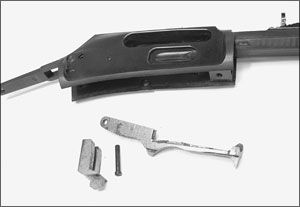
5. As you disassemble the Marlin’s trigger-guard plate, make note (or take a photo) of the relative positions of these parts for ease of reassembly later. Using a pin punch and small hammer, drive out the trigger and sear pin (#69) and the trigger (#68) and sear (#65) can be removed from the trigger-guard plate. Using the same procedure, drift out the trigger-safety block pin (#75), and the trigger-safety block (#74) and its spring (#76) can be lifted out the top.
6.To disassemble the breechbolt and finger lever, the extractor (#25) is first removed from the breechbolt (#2) by carefully prying it out of its slot and to the side. A small screwdriver will work for this. Using a suitable pin punch and hammer, remove the rear firing-pin retaining pin (#23) by drifting it (from top to bottom) out of the bolt. The rear firing pin (#22) and the firing-pin spring (#24) can now be removed. Remove the front firing pin (#21) by driving out the front firing-pin retaining pin (#23). The firing pin will now slide out to the rear of the breechbolt.
To disassemble the finger lever, the finger-lever plunger (#17) and its spring (#19) are removed by using a suitable pin punch and hammer to drift out the finger-lever plunger pin (#18.)
Further disassembly of the action is not required for normal maintenance. And reassembly, of course, is accomplished by simply reversing the order of the above procedures.


























Hello,
I have a 1972 Marlin 336C in need of the rear sight. Is part # 58, rear sight assembly, (consisting of part # 59, 60 & 61) still available for purchase?
Thank you,
Tom